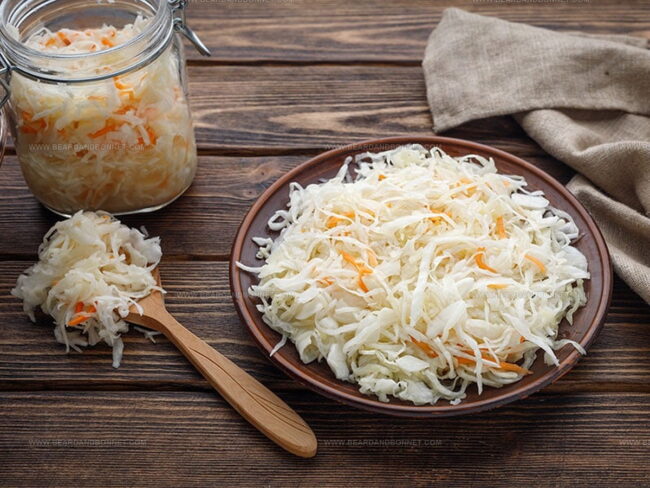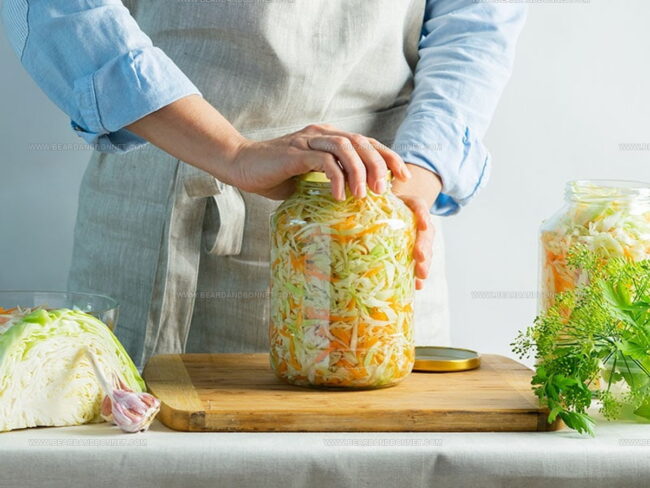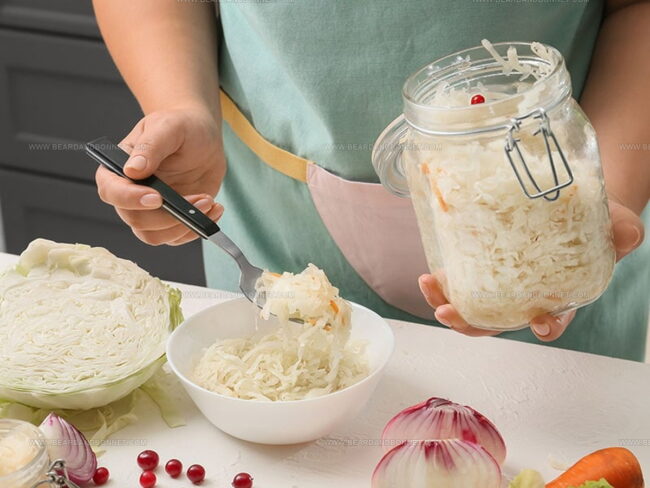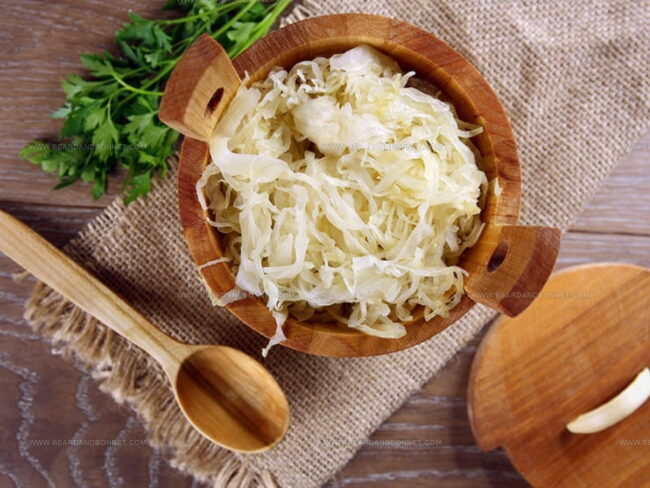What Does Sauerkraut Taste Like? Tart Tanginess Explained
Sauerkraut's unique flavor profile has intrigued food lovers for generations.
This fermented cabbage dish carries a rich cultural heritage across many European regions.
Tangy and complex, the taste can surprise those encountering it for the first time.
Some people find its initial sharpness intimidating, while others become instant fans of its robust character.
Fermentation transforms simple cabbage into a powerhouse of culinary intrigue, creating layers of depth that challenge traditional expectations.
The journey of understanding sauerkraut's taste involves more than just a single bite.
Curious palates will find this exploration both delightful and enlightening - prepare to unravel the delicious mystery behind this traditional fermented delicacy.
What Is Sauerkraut?
You might have enjoyed it nestled between rye bread in a Reuben sandwich or topping a hot dog.
Meat lovers in Germany know this tangy side dish well.
Sauerkraut means sour cabbage in German, which describes its exact nature.
German cooks make this dish by carefully salting shredded cabbage leaves, coaxing out natural juices and letting them sit and ferment for several days or weeks.
Historical records suggest sauerkraut originated in China, where makers used rice wine for curing, before Genghis Khan's armies spread the technique across regions.
While Germans became most famous for this preserved vegetable, its roots stretch far back in time.
Early settlers found sauerkraut valuable because it provided fresh vegetable nutrients during times without modern cooling methods, helping them survive long winters and distant travels.
Flavor of Sauerkraut
Sauerkraut serves as a fermented cabbage dish with minimal ingredients. Salt typically joins the recipe, but that's nearly the entire process.
Fermentation creates a pleasant tartness similar to kombucha - enjoyable and tangy when done correctly.
Sauerkraut ranges from mildly sweet to deeply sour.
Longer fermentation periods increase its rich flavor profile and sharpness.
Subtle tastes mark this food without harsh or overwhelming notes.
Salt and sourness dominate the experience, especially after extended fermentation periods.
Flavor complexity grows with time.
Cooks often enhance basic sauerkraut by adding:
Subtle spices blend seamlessly, creating deeper taste dimensions without masking the core cabbage essence.
How to Make Sauerkraut at Home
Sauerkraut Making Tips:
What Foods Go Well with Sauerkraut?
Sauerkraut offers more ways to enjoy than most know.
Mixing well with sausages, this food fits nicely in stock-based dishes, stews, and soups.
Salted meats, smoked fish, and hot-smoked salmon pair wonderfully with sauerkraut.
Beer and wine also match its strong flavor.
Tangy sauerkraut works magic in many meals.
Potatoes taste better with its zesty kick.
Morning egg scrambles shine when sprinkled with this fermented treat.
Sandwiches, salads, and avocado toast become more interesting with sauerkraut.
Guacamole and rice bowls welcome its sharp taste as a topping.
Sauerkraut brings life to snacks and meals in countless ways.
Its tart flavor enhances almost any dish.
Some might mistake its sour taste for mold, but true fans know better.
Fermentation creates its unique character, making each batch special.
Classic sauerkraut needs about four weeks to develop.
Salt and sour notes define its signature taste.
Chefs experiment with apple and grape combinations to create unique versions.
Serious sauerkraut makers use pH strips to check their pickle's acidity level, ensuring perfect flavor every time.
How Sauerkraut Smells
Fermented foods carry a special smell that signals good things.
Sour, fresh, and tangy scents mean the process works well.
Sugar helps if you want to adjust the mix.
Ginger works nicely when unsure about the odor.
Chilies can add flavor, but they should not control the whole taste.
Sauerkraut's smell comes from sulfur compounds in cabbage.
These substances might sound scary like mold, but they actually help your health.
Some folks feel nervous about trying it.
Taste depends on personal preference.
Some like mild salt levels while others want more intense saltiness.
Watching for jars with special locking lids helps check salt amounts.
How to Know If Sauerkraut Has Gone Bad
Signs show when sauerkraut spoils or goes past its prime.
Clues exist for spotting bad fermented cabbage.
Sniff the sauerkraut when opening refrigerator doors.
Bad smells mean trouble.
Rotten sauerkraut stinks like dirty socks and needs throwing away.
Watch for weird color changes different from original cabbage hue.
Slimy texture means certain spoilage.
Toss it out without hesitation.
Sauerkraut and kimchi demand sealed storage containers.
Proper containers keep pickled vegetables fresh and safe.
Selecting right storage helps maintain fermented cabbage quality and prevents quick spoiling.
Kimchi vs. Sauerkraut Differences
Key differences exist between these fermented foods, whether shopping at stores or crafting homemade versions. Four main distinctions separate kimchi and sauerkraut:
Sauerkraut Fermentation Time
Small sauerkraut batches can be ready in 5-7 days.
Shorter fermentation periods mean fewer helpful probiotics.
Cabbage fermented for less than 14 days contains three times fewer healthy compounds compared to batches fermented for 2-3 weeks.
Checking sauerkraut's taste matters most.
Sauerkraut should offer a nice sour flavor with a light vinegar smell.
Serious sauerkraut makers might want pH strips.
Sauerkraut reaches its best state when acidity sits between 3.8 and 3.9.
Larger sauerkraut batches take more time to ferment.
Warmer spaces speed up fermentation while cooler areas slow down the process.
Is Eating Sauerkraut Every Day Healthy?
Sauerkraut packs a powerful punch of probiotics that support gut health.
Its rise in popularity comes from unique characteristics that set it apart from other foods.
Pasteurization can change the taste of fermented foods, creating a flavor profile quite different from the original.
Sauerkraut serves as a versatile vegetable side or condiment in many meals.
Loaded with essential vitamins, minerals, and nutrients, it offers a fat-free and cholesterol-free option for health-conscious eaters.
Fermented cabbage brings multiple benefits beyond its basic nutritional profile.
Chefs and home cooks appreciate its flexibility in different recipes.
Sauerkraut contains minimal fat and zero cholesterol while providing rich nutritional value.
Its journey to widespread recognition connects closely with food preservation techniques.
Pasteurization impacts fermented foods, shifting their taste and overall sensory experience significantly.
Sauerkraut delivers a complex flavor spectrum ranging from tangy and salty to deeply pungent.
Unique processing methods contribute to its distinctive taste and widespread appeal.
Fermentation techniques transform simple cabbage into a robust, flavorful ingredient.
Traditional preparation methods help maintain its signature taste and nutritional benefits.
What Happens to Your Stomach with Sauerkraut?
Small amounts of sauerkraut help support gut health.
Probiotics work wonders for digestive wellness.
Eating sauerkraut regularly can boost your body's good bacteria.
Moderation matters when adding this fermented food to meals.
Exploring multiple fermented foods offers wider health advantages.
Different fermented options contain unique probiotic strains that support digestive systems.
Selecting fermented vegetables that shift gut pH provides maximum wellness benefits.
Smart choices include kimchi, miso, fermented soy sauce, and cultured dairy products.






Jessica Martin
Recipe Developer & Food Writer
Expertise
Recipe Development, Food Styling and Photography, Seasonal and Local Ingredients, Vegetarian and Vegan Cuisine, Culinary Education
Education
Portland Community College
Oregon Culinary Institute
Jessica Martin is a talented food writer and recipe creator who specializes in seasonal cooking and approachable home baking.
Educated at Portland Community College with additional pastry training from Oregon Culinary Institute, Jessica’s culinary journey spans nearly a decade of creating and sharing flavorful recipes.
Her deep appreciation for local ingredients shapes each of her recipes, making them both accessible and inspiring. At Beard and Bonnet, Jessica uses her cheerful, down-to-earth writing to help readers effortlessly bring new tastes and creative dishes into their daily routines.